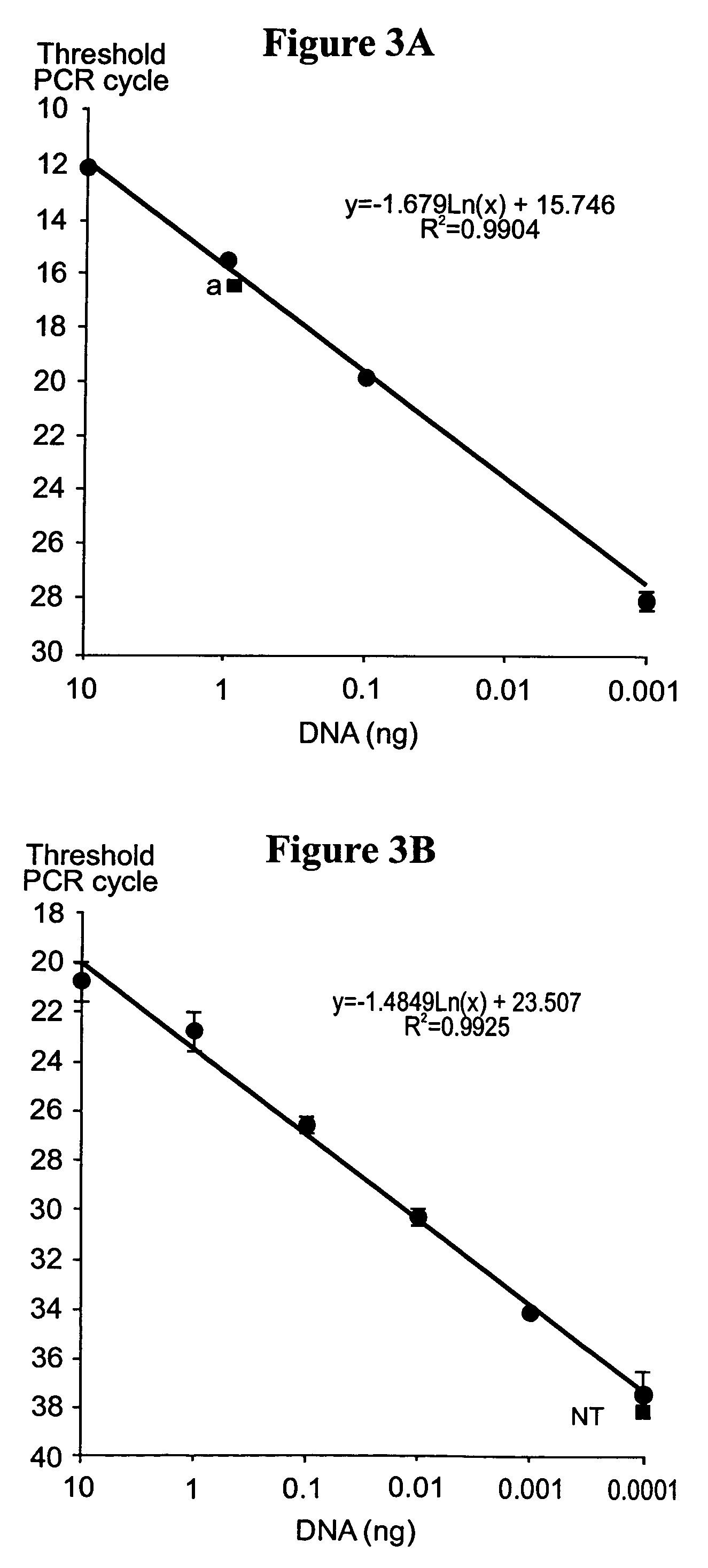Assay for quantitation of human DNA using Alu elements
- Summary
- Abstract
- Description
- Claims
- Application Information
AI Technical Summary
Benefits of technology
Problems solved by technology
Method used
Image
Examples
example 1
[0038]Sample #1 was prepared as follows. Approximately 1 μl of capillary blood from a male donor was washed twice in 500 μl of distilled water and mixed with a conventional reaction buffer for PCR. See, e.g., Chien et al., J. BACTER. 127:1550 (1976). The mixture was mixed with 100 μl of a known amplification buffer—10 mM Tris-HCl, pH 8.4 at 20° C., 1.5 mM MgCl2, 50 mM KCl, 2′-deoxyadenosine 5′-triphosphate (dATP), 2′-deoxycytidine 5′-triphosphate (dCTP), 2′-deoxyguanosine 5′-triphosphate (dGTP), 2′-deoxythymidine 5′-triphosphate (dTTP), 0.2 mM each, 1.2 mM each primer. A conventional PCR followed, using approximately 40 cycles over approximately 3 hours. The generation of PCR products or amplicons was directly monitored using a PCR machine with an optical detection unit (quantitative PCR machine). The amplification of human template DNA resulted in an exponential increase in the amount of product produced.
example 2
Inter-Alu Assay of Human / Primate DNA
[0039]Sample #2 was prepared as follows. Equal amount of human and chimpanzee DNA derived from tissue culture lines were mixed together and subjected to the same amplification protocol outlined above. Using this approach we were able to compare the amplification derived from a human template to that of a mixed template and that of a sample that contained only non-human primate DNA (pygmy or common chimpanzee). The assay resulted in the exponential amplification of DNA in samples that contained human DNA templates and essentially no amplification in samples that only contained non-human primate DNA.
example 3
Inter-Alu Assay of Human / Mammal DNA
[0040]In this example DNA derived from cell lines or from peripheral lymphocytes derived from a number of different mammals was subjected to inter-Alu PCR and optical detection. Since Alu repeats are contained only within members of the primate order and recently integrated Alu elements are found only within the human genome, little or no amplification was to be expected in the test samples that contained the DNA of other animals as templates. As was to be expected, essentially no amplification of PCR products was detected in these samples. That demonstrated the specificity of the assay.
PUM
| Property | Measurement | Unit |
|---|---|---|
| Fraction | aaaaa | aaaaa |
Abstract
Description
Claims
Application Information
 Login to View More
Login to View More - R&D
- Intellectual Property
- Life Sciences
- Materials
- Tech Scout
- Unparalleled Data Quality
- Higher Quality Content
- 60% Fewer Hallucinations
Browse by: Latest US Patents, China's latest patents, Technical Efficacy Thesaurus, Application Domain, Technology Topic, Popular Technical Reports.
© 2025 PatSnap. All rights reserved.Legal|Privacy policy|Modern Slavery Act Transparency Statement|Sitemap|About US| Contact US: help@patsnap.com



